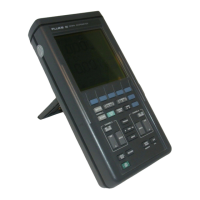3-2
CIRCUIT DESCRIPTIONS
3.2 FUNCTIONAL BLOCK
DESCRIPTION
3.2.1 Introduction
This
section contains an overall
block diagram of the ScopeMeter. Refer to figure
3.1
.
The
block diagram can be divided
in two parts. The upper part of the diagram
shows components
that are situated on the Printed Circuit Board
(In the following text: PCB), that
Is connected to the
ScopeMeter^s
bottom cover. Because this PCB contains
mainly analog circuits, it
is
called
the analog
A2PCB.
The lower
part of the diagram contains the digital circuitry
of the ScopeMeter. This circuitry Is
located
on the digKal
A1 PCB, the PCB connected to the
ScopeMeter’s lop cover
The general
layout of the block diagram is
the same as the layout of the circuit diagrams
In chapter
10.
The circuits that can be found on the
same circuit diagram (chapter 1
0)
are placed
in a dashed
box in the block
diagram.
Analog A2 PCB
The signals
at
the red
and gray 6NC input connectors are
attenuated Oy the CHANNEL A
ATTENUATOR section and
the CHANNEL B ATTENUATOR. These
attenuators are set by the
Microprocessor (on
the digital A1 PCB) via the ANALOG
CONTROL CIRCUIT. Also input protection
circuits are provided here.
The
output
signals
of the attenuator blocks are fed
to the ANALOG ASIC (ASIC
»
Application
Specihe
Integrated Circuit).
TNs component is controlled
by
the
ScopeMeter’s microprocessor (on the digital
A1 PCB). The Analog ASIC incorporates
signal amplification
and channel selection. It also prepares
the signal for sampling
by the Analog to Digital Converter (ADC).
The red and black banana connectors
are connected to the EXTERNAL (BANANA)
IN PUT/0UTPUT
CIRCUIT. When the ScopeMeter Is set
to
mV.
DIODE or OHM METER mode,
the External (banana)
input/output circuit outputs its signal Into
the Channel A Attenuator section.
In SCOPE mode, the
circuit can act as
a
trigger input. The
trigger signal Is fed to the Analog ASIC.
In the Analog ASIC
"channel A", "channel
B" or "External thggeh' can be selected
as
trigger
source. The trigger signal is
used to generate the DELTA-
T
voltage
(time relation between
trigger moment and sampling
momer^t).
The built-in GENERATOR uses the External
(banana) input/output circuitry
as
output. It is
possible
to generate a DC voltage and a square wave voltage.
ScopeMeter model 97 also can
generate sine
wave voltages, a ramp voltage, and a ramp current.

